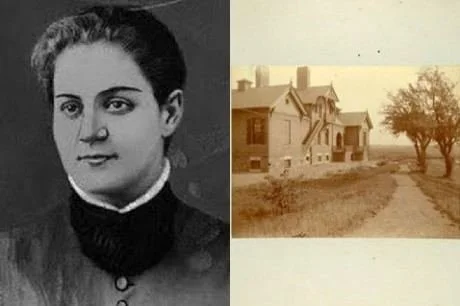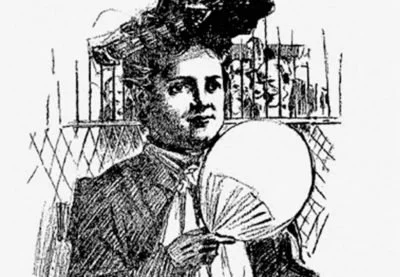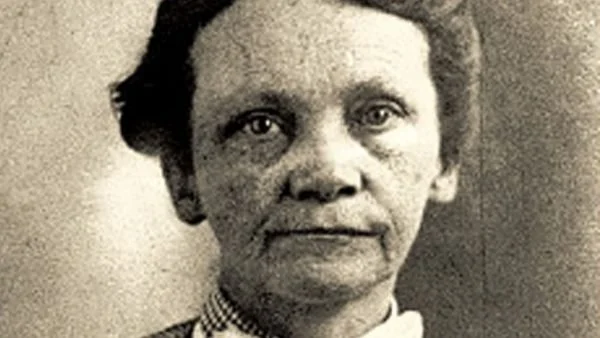The Tale of Jolly Jane
Jane Toppan, also known as "Jolly Jane," was well liked among her peers. She was always cheerful, caring and easy to talk to. Her colleagues loved listening to the stories she told about her life, and never doubted the grand nature of them. At the time, in the late 19th Century, doctors worked to develop medicine and medicinal practices. No one questioned when a patient died, because it happened all the time. It was almost a natural occurrence.No one questioned Jane when her patients started dying either.
Early Life
Born Honora Kelley in 1854, Jane belonged to a family of Irish immigrants in Massachusetts. She had three sisters and the family lived in poverty. Sadly, Jane's mother died of tuberculosis when she was an infant. As the years went by, her father, Peter, slowly lost his sanity. According to the New England Historical Society, he even sewed his eyelids shut. Known as "Kelley the Crack," Peter allegedly abused his daughters and in 1863, he checked them into the Boston Female Asylum, an orphanage, because he couldn't care for them.Ann Toppan arrived at the orphanage in search of a servant to help around the house. Jane went with the Toppans in indentured servitude, and took their last name for her own. Because of the stigma surrounding Irish people at the time, the Toppans told everyone Jane's family was Italian, and that her parents died at sea. At the Toppan household, Jane developed an interesting relationship with their daughter, Elizabeth. The two were close in age, and acted friendly to one another. Yet, Elizabeth always took the time out of her day to remind Jane of her position in the family. Although Jane acted nice on the outside, her resentment towards the girl grew over time.Jane was well-liked by the community. They trusted her to watch their children, and grew fond of the character she showed them. This is because Jane was a pathological liar. She often told tall tales and spread gossip. Some of these rumors were aimed towards her classmates to purposefully get them into trouble. Whenever she was caught, she had the uncanny ability to talk her way out of it. This deadly ability allowed her to get away with her crimes for the decades to come.
Nursing and Experimentation
Although the Toppans released Jane from her servitude when she turned 18, she continued to live with them. Shortly after Ann's death, Elizabeth took over the household and eventually married. Her husband, Oramel Brigham, moved in with them later on. Eventually, Jane left the house herself. It is suspected that the trio disputed often, and Jane had had enough.At 33, she pursued a nursing career with Cambridge Hospital School of Nursing in Massachusetts. There, she received the nickname "Jolly Jane." Her upbeat attitude and kindness towards those around her made her rise in popularity.It was at the Cambridge Hospital where Jane began to experiment with medications and their effects on the patients. She seemed to favor morphine, and tested its potency on them. She additionally combined morphine with atropine to induce paralysis. Then, she would sexually abuse them. According to All That Interesting, she often gave her patients too much of the drug concoction and as they slowly drifted away, she would caress them and hold them.Although many patients died, no one suspected her of foul play. Her demeanor seemed to sway their opinion, and because medicine was not as advanced as it is today, the hospital administrators believed the patients died of natural causes. They even valued her so much that they recommended her to the prestigious Massachusetts General Hospital.At the General Hospital, Jane continued her experiments, but was fired for negligence. The staff didn't catch her for poisoning her patients; instead, they caught her administering opiates to patients who requested then. Shortly after, Jane went back to Cambridge, but was fired yet again.With the help of recommendations from the hospital staff, she was able to start her final career as an at-home-caregiver.
Caregiving Career and Murder Spree
Jane took up various jobs caring for the sick and elderly members of rich families. For years, she infiltrated these families and poisoned her victims whenever she became bored of them. By forging medical documents, Jane was able to obtain copious amounts of morphine to use on her victims.In 1899, her foster sister, Elizabeth, invited her to visit. Fueled by the hatred cultivated over the years, Jane poisoned Elizabeth with mineral water laced with strychnine. Later, when police officers interrogated her, she admitted that Elizabeth's death was particularly gratifying.“I held her in my arms and watched with delight as she gasped her life out,” she said.She attempted to seduce Elizabeth's husband, Oramel Brigham, and when things didn't work out, she resorted to poisoning him. She believed that if she then saved his life, he would fall in love with her. Yet, when Brigham recovered, he promptly fired her.Things started going downhill with the Davis family, however. Jane rented a cottage from the Davis family in the summer of 1901. She had failed to pay her rent, and accumulated around $500 in debt, which is around $15,000 in today's currency. Rather than discuss things with the Davis family, Jane resorted to poison yet again. Within six weeks, the she decimated the entire family.
Arrest and Trial
However, investigators had trailed Jane for quite some time, despite her knowledge. Authorities exhumed Mary Gibbs, a member of the Davis family, and found evidence of morphine poisoning.Police apprehended Jane Oct. 29, 1901. During her interrogation, Jane admitted that she obtained sexual gratification from poisoning her victims with morphine. She additionally received gratification by holding them as they died. Although she only admitted to killing 31 people, historians suspect the number to be well over 100. Since Jane worked as a nurse in various hospitals, it is entirely possible that she claimed other victims' lives with her fascination with death and the effects of morphine.The trial began in 1902, and throughout its entirety, Jane recalled the deaths of her victims in a pleasant matter. According to the Daily News, a journalist covering her trial recalled the disturbing story:"Her recital of her crimes makes one's blood run cold. She has told of the death of her victims as if she were talking about a summer picnic at which she enjoyed herself."By the end of the trial, the jury found her not guilty by reason of insanity. She then spent her life inside the Taunton State Mental Hospital, where she died Aug. 17, 1938.Her one regret? That she was not able to "to have killed more people – more helpless people – than any man or woman who has ever lived."









